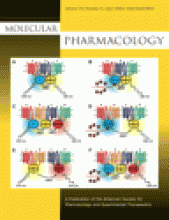Abstract
Heat shock proteins represent an emerging model for the coordinated, multistep regulation of apoptotic signaling events. Although certain aspects of the biochemistry associated with heat shock protein cytoprotective effects are known, little information is found describing the regulation of heat shock protein responses to harmful stimuli. During screening for noncanonical β adrenergic receptor signaling pathways in human urothelial cells, using mass spectroscopy techniques, an agonist-dependent interaction with β-arrestin and the 27-kDa heat shock protein was observed in vitro. Formation of this β-arrestin/Hsp27 complex in response to the selective β adrenergic receptor agonist isoproterenol, was subsequently confirmed in situ by immunofluorescent colocalization studies. Radioligand binding techniques characterized a homogeneous population of the β2 adrenergic receptor subtype expressed on these cells. Using terminal deoxynucleotidyl transferase biotin-dUTP nick end labeling, immunoblot analysis and quantitation of caspase-3 activity to detect apoptosis, preincubation of these cells with isoproterenol was found to be sufficient for protection against programmed cell death initiated by staurosporine. RNA interference strategies confirmed the necessity for Hsp27 as well as both β-arrestin isoforms to confer this cytoprotective consequence of β adrenergic receptor activation in this cell model. As a result, these studies represent the first description of an agonist-dependent relationship between a small heat shock protein and β-arrestin to form a previously unknown antiapoptotic “signalosome.”
Footnotes
-
This work was supported in part by the National Institutes of Health National Institute of Diabetes and Digestive and Kidney Diseases [Grant DK062865]; the National Institutes of Health National Institute of General Medical Sciences [Grant GM66726]; National Institutes of Health Biomedical Research Infrastructure Networks (BRIN) program [Grant RR016471]; the National Institutes of Health Centers of Biomedical Research Excellence (CO-BRE) program [Grant RR017699]; and by a Thesis Grant, Faculty of Graduate Studies, Mahidol University.
-
L.R and E.B.H. contributed equally to this work
-
ABBREVIATIONS: HSP, heat shock protein; AR, adrenergic receptor; 7TMR, seven-transmembrane receptor; HSP27, 27-kDa heat shock protein; RNAi, RNA interference; DMEM, Dulbecco's modified Eagle's medium; ISO, isoproterenol; [125I]CYP, (-)3-[125I]iodocyanopindolol; CGP 20712A, 1-[2-((3-carbamoyl-4-hydroxy)phenoxy)ethylamino]-3-[4-(1-methyl-4-trifluoromethyl-2-imidazolyl)phenoxy]-2-propanol methanesulfonate; ICI 118,551, erythro-dl-1-(7-methylindan-4-yloxy)-3-isopropylaminobutan-2-ol; SR 59230A, 3-(2-ethylphenoxy)-1-[(1S)-1,2,3,4-tetrahydronaphth-1-ylaminol]-(2S)-2-propanol oxalate; PAGE, polyacrylamide gel electrophoresis; IP, immunoprecipitated; LC/MS/MS, liquid chromatography/tandem mass spectrometry; HA, hemagglutinin; PBS, phosphate-buffered saline; siRNA, small interfering RNA; STS, staurosporine; TUNEL, terminal deoxynucleotidyl transferase biotin-dUTP nick-end labeling; PI, propidium iodide; RFU, relative fluorescence units; SR 59230A; PI3K, phosphoinositide 3-kinase; MAPK, mitogen-activated protein kinase; MK2, mitogen-activated protein kinase-activated protein kinase-2; Akt, protein kinase B.
-
↵1 Current affiliation: Sanford Research/University of South Dakota, Cardiovascular Research Institute, Sioux Falls, South Dakota.
-
↵2 Current affiliation: Case Center for Proteomics, School of Medicine, Case Western Reserve University, Cleveland, Ohio.
- Received November 12, 2008.
- Accepted January 21, 2009.
- The American Society for Pharmacology and Experimental Therapeutics
MolPharm articles become freely available 12 months after publication, and remain freely available for 5 years.Non-open access articles that fall outside this five year window are available only to institutional subscribers and current ASPET members, or through the article purchase feature at the bottom of the page.
|






